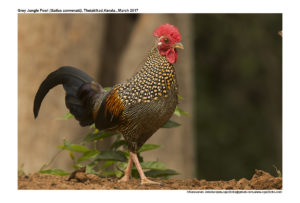
Grey-jungle FowlGallus sonneratii
Etymology:
- Gallus : Latin word for Farmyard cock
- Sonneratii : Named after French Naturalist Pierre Sonnerat (1748–1814)
Vernacular Names: Hindi: Junglimurgha (M), Junglimurghi (F), DesiMurg, Raj: Komri, Gond: Geerakur, Pardakomri, Guj: Junglimurgo, Ruperijunglikukdo, Mar: Rakhi ran kombda (M), Raankombdi, Ta, Mal: Kattukozhi, Te: Tellaadavikodi, Kan: Kaadukoli
Distribution in India: Resident of peninsular India
Description:
Size of male is 70–80 cm, wt. of male is 790–1136 g; size of female is 38 cm, wt. of female is 705–790 g. The male is greyer with rather small comb and hackles, and very distinctive neck pattern; boldly spotted whitish, has blunt neck hackles, no whitish patch at base of tail, brighter legs and less obviously elongated scapulars. The non-breeding (eclipse) plumage of male sheds spotted neck hackles and elongated rectrices, while head and neck feathers are shorter and dull black, and comb is reduced in size and paler. The female has a combination of white streaks on breast and unbarred flight feathers. It has yellowish flesh near bill with dark brown culmen, irides are yellow to orange-brown, and legs yellow to red(brightest in breeding season). The male has single, long spur, whereas female is usually unspurred. The juvenile is similar to female, but darker especially on underparts. Theyoung male soon shows characteristic grey and rusty feathers of adult male, and has blacker tail thanfemale. The first-year male has hackles, spurs and central rectrices that are shorter than adult, duller overall but retains female-like wing feathers.
Habitat:
It is found in understorey, bamboo, and scrubby parts of evergreen, mixed and deciduous forest. It is found from lowland to 2400m.
Food habits: It eats seeds of bamboo, shoots of grass and crops, tubers, figs and berries, insects likegrasshoppers and termites and small reptiles. It pecks at dung of cattle and elephants. Itforages close to cover and in same area during successive days, presumably responding to local distribution of food supplies.
Breeding habits:
Breeds more or less throughout year; Feb-March in Nilgiris, Mar- Jul in Travancore.They nest in small hollows next to bush, bamboo. They lay a clutch of 4–5 eggs although larger clutches may be produced by two females when they mate with same male. The incubation period is 20–21 days, by female alone. Male brings food for chicks.